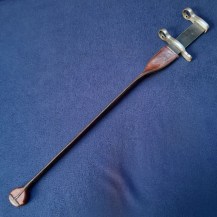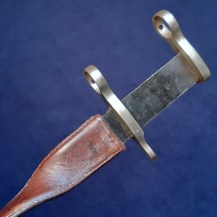US M1912 Fencing Bayonet for the Trapdoor Fencing Musket
Flexible steel ‘blade’ with looped end, brown leather cover, bare exposed tang, hilt with muzzle ring and lower lobe quillon, pommel piece with second muzzle ring, both rings with a drilled hole for a set screw. Blade 16½ inches (41.9cm) in length, 19½ inches (49.5cm) overall.
The leather cover is stamped with ‘HEK’ – this is an inspector’s mark for Henry E Kelsey, leather goods inspector at Rock Island Arsenal (RIA). The steel parts would have been fabricated at Springfield Armory, but RIA produced the leather covers in their ‘Harness and Accoutrements Shop’.
Seeking to improve soldiers’ skills at bayonet fighting, the US Army commissioned a number of different models of ‘fencing bayonets’ from as early as 1852, to allow a more realistic simulation of combat. Early versions used a flexible whalebone blade screwed in to a cut-down metal socket, then in 1897 the first all-steel model was introduced. The M1906 Fencing Bayonet was the first to be based on the knife bayonet, imitating the M1905 bayonet for the Springfield rifle.
Technically speaking the Army never commissioned an ‘M1912’, this is just a more convenient way of referring to the third variation of the M1906. The difference is substantial, however: the M1912 was introduced in that year to remedy some defects in its predecessor the M1909, which was deemed to be too easily broken and reportedly caused “ugly wounds” when the blades broke in sparring creating sharp edges. This understandably discouraged bayonet training and the Inspector General complained in annual reports that soldiers’ skills were suffering.
To fix the issue the M1912 went back and reintroduced some features that had been mistakenly removed since the socket bayonet days: a horizontal blade, achieved by adding a 90-degree twist starting 2 inches forward of the hilt, and a leather cover over the full length of the blade. Letting the blade spring up and down rather than side to side was found to reduce breakages, and even if they did occur the leather would keep sharp edges covered.
The new model was a success and 11,000 were made between 1913 and 1915, getting the infantry trained up in time for the United States’s entry into WW1. It attached (with two screws through the muzzle ring holes) to the Trapdoor Fencing Musket, a training piece made at Springfield Armory by converting obsolete .45-70 Trapdoor rifles. These had their barrels and stock shortened to mimic the length and weight of the M1903 rifle, and the sights, external hammer and sling swivels removed. The M1912 bayonets remained in use throughout WW1 and remained in stores for some time afterward, eventually being sold as surplus.
The blade remains flexible. All the leather cover’s stitching is intact, some creasing and light rubbing to the leather surface, more prominent on the ball end piece, but no damage. The exposed section of the blade retains a blued finish, the hilt parts are bright and clean.








